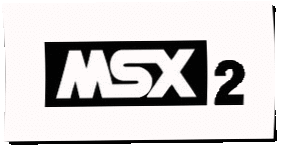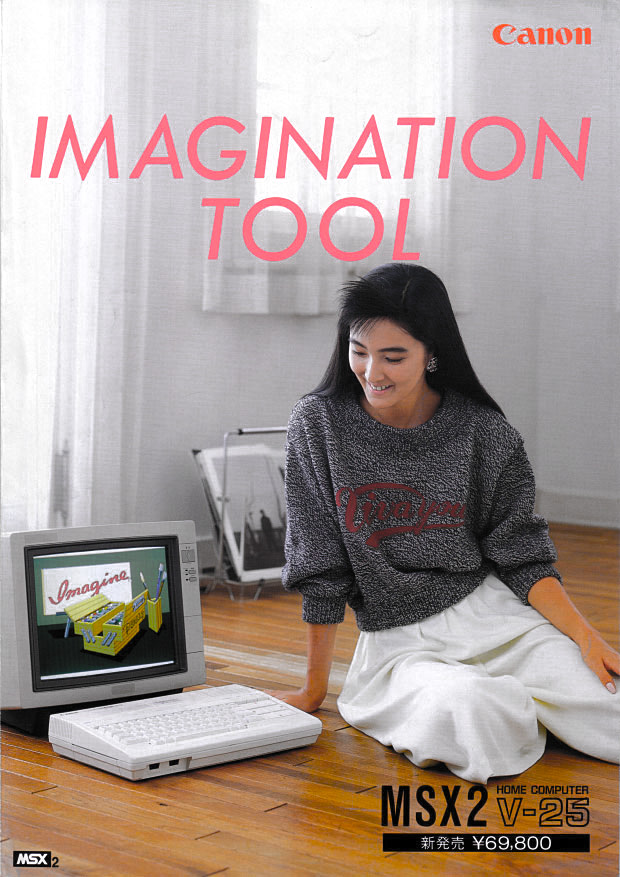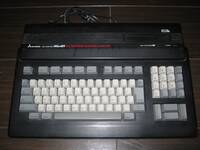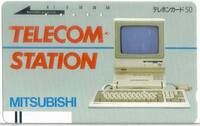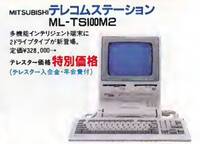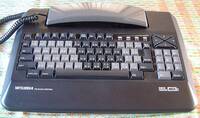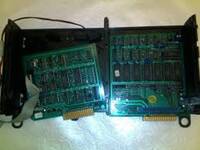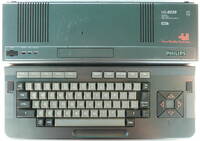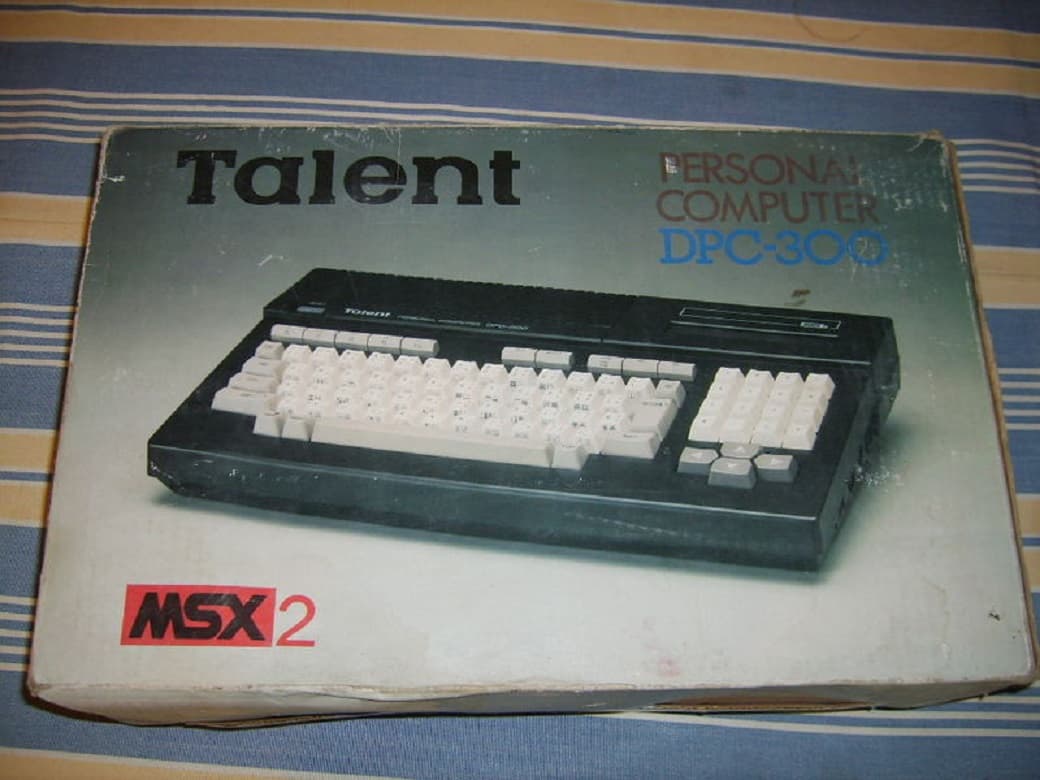MSX2
1985

After the (relative) success of the MSX 1 computer (in Japan, Europe and South America), Microsoft and ASCII presented its successor. The main new feature was the very enhanced graphic modes, no other computers were able to display such graphics! The 128 KB VRAM was very impressive! It had a battery-backed clock and a new MMU (to handle more than the Z80 64KB limit). The MSX 2 standard, like the MSX 1, was designed by ASCII, the new operating system MSX DOS 2.0 was designed by Microsoft (its almost a copy of MS-DOS 3.3). A while after launching the MSX 2 standard, Microsoft abandoned the project, but several manufacturers took it over.
*Canon
V25
V30
V35
*Daewoo/Yeno
IQ-2000 CPC-300 (RAM 128KB Mapper / VRAM 128KB) (1986/Korea)
IQ-2000 CPC-300E (RAM 64KB Mapper / VRAM 128KB / No Joystick Port) (1987/Korea)
X-II CPC-400 (RAM 128KB Mapper / VRAM 128KB / 1 FDD / Hangul Font) (1987/Korea)
X-II CPC-400S (RAM 128KB Mapper / VRAM 128KB / 1 FDD / Hangul Font / Superimpose) (1988/Korea)
Zemmix
*Carchano - ACVS (Brazil) solo accesorios
Upgrade Kit
Expert2
Expert3
DDX (Brazil, upgrade kit)
*Hitachi
MB-H3
MB-H70
*JVC (a.k.a. Victor Company of Japan, Limited)
HC 180
HC 90
HC 95
*National
FS-5500F1/F2 (RAM 64KB / VRAM 128KB / 1 or 2 FDDs / JIS 1st Class Kanji / Superimpose) (1985/Japan)
FS-4500 (RAM 64KB / VRAM 128KB / 1 Printer / JIS 1st Class Kanji) (1986/Japan)
FS-4700 (RAM 64KB / VRAM 128KB / 1 FDD / 1 Printer / JIS 1st Class Kanji) (1986/Japan)
FS-5000F2 (RAM 128KB Mapper / VRAM 128KB / 2 FDDs / JIS 1st Class Kanji) (1986/Japan)
FS-4600 (RAM 128KB Mapper / VRAM 128KB / 1 FDD / 1 Printer / JIS 1st Class Kanji) (1986/Japan)
*Mitsubishi
MLG 10
MLG 30
ML-TS2H
ML-F120
*Panasonic
FS-A1 (RAM 64KB / VRAM 128KB) (1986/Japan)
FS-A1MK2 (RAM 64KB Mapper / VRAM 128KB) (1987/Japan)
FS-A1F (Japan) (RAM 64KB Mapper / VRAM 128KB / 1 FDD / JIS 1st Class Kanji) (1987/Japan)
FS-A1FM (Japan) (RAM 64KB Mapper / VRAM 128KB /1 FDD / 1 Modem / JIS 1st Class Kanji) (1988/Japan)
*Philips (the Netherlands)
VG-8220 (64kB RAM, 128kB VRAM, built-in Designer program) a.k.a. NMS8220
VG-8230 (64kB RAM (no memory mapper), 128kB VRAM, 360kB 3,5 floppy disk drive)
VG-8235 (128kB RAM, 128kB VRAM, 360kB 3,5 floppy disk drive)
VG-8240 (64kB RAM, 128kB VRAM, 360kB 3,5 floppy disk drive, looks like VG 8230 but with built-in superimpose, rare)
NMS-8220 / 1st released version
NMS-8220 / 2nd released version
NMS-8245 (128kB RAM, 128kB VRAM, 1 720kB 3,5 floppy disk drive)
NMS-8250 (128kB RAM, 128kB VRAM, 1 720K 3,5 floppy disk drive, separate keyboard)
NMS-8255 (128kB RAM, 128kB VRAM, same as NMS 8250 but with 2 720K 3,5 floppy disk drives)
NMS-8280 (128kB RAM, 128kB VRAM, same as NMS 8255 but with superimpose and digitizing capacities)
*Sanyo
AX 370 (Arabic)
Wavy 2
Wavy 23
*Sony
HB-F1 (RAM 64KB / VRAM 128KB) (1986/Japan)
HB-F1II (RAM 64KB Mapper / VRAM 128KB) (1987/Japan)
HB-F1XD (RAM 64KB Mapper / VRAM 128KB / 1 FDD) (1987/Japan)
HB-F1XDMK2 (RAM 64KB Mapper / VRAM 128KB / 1 FDD) (1988/Japan)
HB-F5 (RAM 64KB / VRAM 128KB / JIS 1st Class Kanji) (1985/Japan)
HB-F500 (RAM 64KB / VRAM 128KB / 1 FDD / JIS 1st Class Kanji) (1985/Japan)
HB-F500P
HB-F700D (Germany)
HB-F700F (France)
HB-F700P
HB-F700S (Spain)
HB-F900 (RAM 256KB Mapper / VRAM 128KB / 2 FDDs / JIS 1st Class Kanji / Superimpose) (1987/Japan)
HB-F9P (RAM 128KB / VRAM 128KB / built-in Memovision application software, with Sony datacartridge support but no built-in disk drive)
HB-F9S (Spanish version of F9P)
HB-G900P
HB-T600 (RAM 128KB Mapper / VRAM 128KB /1 FDD / 1 Modem / JIS 1st Class Kanji / Terminal) (1986/Japan)
HB-T7 (RAM 64KB / VRAM 128KB / 1 Modem / JIS 1st Class Kanji) (1986/Japan)
*Spectravideo
SV-838 (MSX2 compatible PC)
*Talent (Argentina)
TPC-310 (Sold in Argentina and Chile)
TPC-311 (Sold in Argentina and Chile)
TPC-312 (Sold in Argentina and Chile)
DPC-300 (Sold in Chile)
*Toshiba
HX-33
HX-34
*Yamaha (Japan)
AX 350 (Arabic)
AX 500 (Arabic)
YIS-503IIIR
YIS-805/128R2
CX7M
CX7M-128
CPU Zilog Z80A or equivalent
Velocidad 3.58 MHz
Co-procesador Video Pantalla Processor : V9938 (MSX-VIDEO)
RAM at least 64 KB
VRAM at least 64 KB
ROM 48 KB
Modos de Texto 40 x 24 / 32 x 24
Modo gráfico 64 x 48 / 256 x 192 / 256 x 212 / 512 x 212
Coloresc 512
Sonido 3 channels, 8 octaves
Puertos de entrada/salida Joystick(1 or 2), Cartridge(2), Tape(1200/2400 baud), RGB, Composite Video, Centronics, External Audio
OS MSX DOS 2.0 (available on a optional cartridge)
 video games gallery from the last century
video games gallery from the last century
































